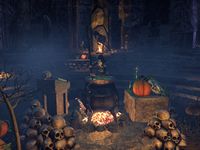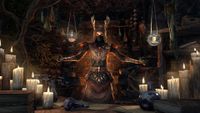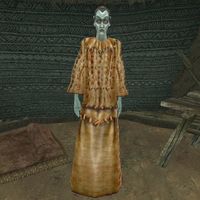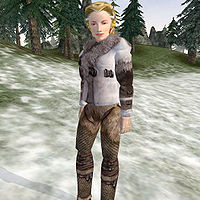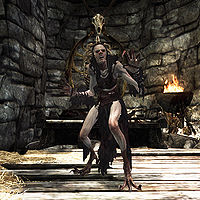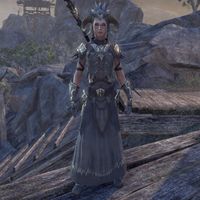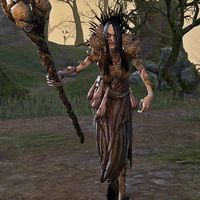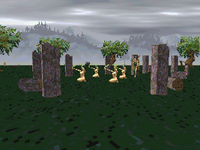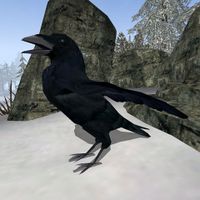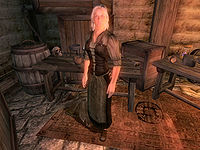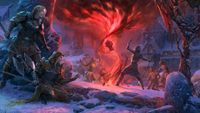Lore:Witches
Witches and Witch-men are practitioners (typically female)[1] of hedge-magic known as witchcraft.[2] They tend to gather in covens that vary in faith and practices (see below). Witchcraft is often seen in a negative light, and practitioners are sometimes persecuted by witchhunters, individuals that specialize on rooting out and destroying dark cults and profane sorcery.[3]
There are a variety of ways to become a witch, and traditions vary across Tamriel. Some witches receive the Secret Mark of Power in an arcane ritual, while others seek the patronage of a Daedric Lord. Witchcraft is said to involve opening oneself to the invisible world.[4]
The Witches Festival is an annual holiday that falls on the 13th of Frostfall, coinciding with Mephala's summoning day. During the festival, the denizens of Tamriel defy their superstitious fears. Ghosts, demons, and evil spirits are mocked and celebrated by both occult occurrences and outrageous costumes.[5] Sinister types gather in the wilderness outside cities. The creatures they create or summon may plague Tamriel for eons.[6] The Witches Festival earns its name as the most sacred holiday for witches.[7]
Racial Differences[edit]
Bretons[edit]
In High Rock, the Wyrd Covens are a Bretonic subculture of nature-witches, the Beldama and Glenmoril Wyrd being two major ones. Some myths place the creation of the Wyrd in the Dawn Era, when Y'ffre's Naming (which gave all creatures of Nirn their shape)[8] and his transformation to the first of the Earthbones occurred. The Wyrd were to be wardens of nature, descended from the Ehlnofey themselves.[9] In the modern day, beliefs among the various Wyrd Covens vary. The Beldama Coven for example still reveres Jephre and their Elnofey heritage,[10] while the various branches of the Glenmoril Wyrd lean towards worshipping the Daedra.[11]
They stem from the same traditions as the Nedic ancestors of the Bretons, the Druids of Galen,[12] but a religious schism brought about the Wyrd's separation.[13] Repulsed by Mer and the civilization-embracing druids they referred to as "barons in ivy robes", these witches retreated into isolation, and sought out the Earthbones in their efforts to prostrate themselves before unmarred nature.[13][14] Once a singular entity, the Wyrd split into subgroups by the time of the last Druid King's voyage to the Systres.[15][16] These sisterhoods remained behind on the mainland to safeguard the forests of High Rock,[17] with some of the dozen or so covens even spreading throughout Tamriel.[10] The Wyrd's way is to turn away from civilization altogether, and to live in nature as beasts do.[13]
In remote regions of High Rock, such as Glenpoint and the Wrothgarian Mountains, witches and medicine men are held in high regard by the superstitious country-folk because of their impressive magical feats.[18] Many witches' coven dedicated to nature worship can be found in Daenia's forests.[19]
The Breton tradition of cremating the dead dates back to the days of High Rock's witch kings, who ruled over the Bretons at some point in their history.[20][UOL 1] Tiber Septim easily conquered the squabbling Breton kingdoms, but would find it impossible to truly squash the sectarian conflicts between them that hampered trade and prosperity.[21][22] Septim opted to entrust a governor of his choosing to end the feud between High Rock's witch-kings, which was a successful endeavor.[23]
Dunmer[edit]
In Morrowind, witches, similarly to warlocks, are typically bound to the service of a Daedric Prince in hopes of receiving power. They are inclined to worship the Bad Daedra.[24] Witches are drawn towards the Daedric Ruins that dot the province, which are rumored to have been erected by the Princes themselves. However, the Tribunal Temple is known to keep the ruins clear from any Daedric cults that may hope to spring around them.[25]
The Mabrigash are an Ashlander tribe primarily made up of renegade wise women who have forsaken the established rules of behavior for an Ashlander woman, so that they may master the dark arts and become a witch-warrior.[26][27] Mabrigashes are outcasts among the Ashlanders.[27][28]
One of the most significant witch-warriors in Ashlander history was Sanit-Kil, who in turn worked in the service of the legendary wise-woman, Kinitu-Nila. Sanit-Kil's amulet, the Heart of Fire is a token acknowledged by Vvardenfell's four tribes and it has been passed down among the Erabenimsun's people for years.[29]
In the King Edward series, one of the main characters, Moraelyn is referred to as the "Witch-King" by Edward in the first book.[30]
Imperial[edit]
One of the former Emperors during the Stormcrown Interregnum, Thules the Gibbering, was a Nibenese witch-warrior who, despite his heritage, was not well-liked.[31]:96
One myth regarding the Lucky Old Lady statue of Bravil explains that an Imperial prince, who was taken in by the Lady, was kidnapped and cursed by a band of witches to be rude and horrible.[32]
Maormer[edit]
Sea witches are religious figures or magic leaders among the Sea Elves.[33] They are known for their connection to the sea.[34]
Nords[edit]
The Nords are said to have legendary witch-warriors, whose weapons were engraved with runes. Nordic smiths attempt to replicate this with their secret metalcrafts for their steel weaponry.[35]
The Direfrost Clan were rulers of northern Eastmarch, and were well known for their persecution of witches, which they found their divine calling. The covens were numerous in the area, erecting hovels to the Daedric Princes, and would murder innocents and children.[2][36][37]
The Fryse Hags are an order of savage Nord witches dedicated to the goddess Kyne, the widow of the god Shor. Each hag is a powerful ice mage in her own right, although they have also been known to consort with the undead or use enchanted silver weapons. The hags wander the wilds of Solstheim, living outside civilized society and indiscriminately killing any traveler they come across, viewing outsiders as a despised threat to their beliefs. They are known to congregate in ice caves.[38] Windcallers are Skaal witches dedicated to the All-Maker known for their mastery of wind magic.[39]
Clever Men were occasionally equated to witches.[40]
In the twilight years of the Third Era, a local witches' coven near Whiterun elevated in power when their leader, Jsashe assumed control of the county and even took the title of "Witch-Queen". This was after a series of disasters struck the region and the people blamed and later exalted her. She was a self-proclaimed priestess of Lorkhan and had effective control over the county by 3E 432.[41]
Reachmen[edit]
Reachmen are often referred to as the Witchmen of High Rock, a name given to them due to their use of dark "Reach-magic". It is believed that they learned much of this magic through trading with the Orsimer, their neighbors who also occupy the Wrothgarian Mountains.[18] Hircine is believed to be the source of where Reach-magic is drawn from,[42] though the magic crosses into Molag Bal's domain when the cruel magic of the Gravesingers (Reachmen necromancers) is involved.[43][44][45] Reach-magic has been outlawed within the Mages Guild, though that has not stopped the art from being widely studied.[18]
Hagravens were once witches, but have undergone a ritual, trading their humanity for access to powerful magic. The transformations they undergo infuse their entire beings with some element of that power.[46] Some witches of the Reach source their magic from hagravens, performing "ecstatic ceremonial heres[ies]" such as sacrifices to acquire dark nature magic.[44] Although primarily a Reachfolk tradition, other covens and cultures have been known to produce hagravens.[47][48]
Reachfolk witches respect the ancient witch Naenra Waerr. To honor her, Reach witches who pass the final test of wisdom and power set to them by a clan elder gain the privilege to craft a mask that resembles a headdress Naenra wore while creating the Umbra Sword.[49]
Many young Reachfolk witches perform taming rituals on sabre cats hoping to gain their loyalty.[50] They are also renowned for their Bloodrage tools, which are inlaid with numerous enchantments used by the Reachfolk to harvest runestones more effectively.[51][52]
Icereach Coven and Tagh Droiloch were prominent covens composed primarily of Reachfolk.
Among the Reachfolk, titles and groups like "witch-knights" and "witch-lords" were recognized. The Witch Knight Charger was a variety of horse bred by the Reachfolk.[53][54][55]
Other[edit]
The Witchmother coven is the name for a loose coven of powerful witches who have been transformed into hag-like creatures known as Witchmothers.[56] They venerate Nocturnal and carry out her bidding. The number of coven members is unknowable and ever-changing,[57] and they have been known to take on new members from all over Tamriel.[56] The ashes of venerated witches are used to sanctify arcane "wicker-steeds".[58]
The Witch Tree is a mysterious sentient tree found in Ghast's Pass, a mountain pass in the Western Reach region of Hammerfell, north of Azra's Crossing. It can speak cryptically through the rustling of leaves, and can also move its roots to communicate. It grew around one of the seven Star Teeth, a treasure which it provided to the Soul of Conflict for their confrontation with the Umbra' Keth.[59]
Witch covens of unknown origins exist in High Rock:
- The Daggerfall Witches: The Daggerfall Witches were active in Shalgora circa 3E 405.[60]
- The Daughters of Wroth: The Daughters of Wroth were active in the Wrothgarian Mountains circa 3E 405.[60]
- The Sisters of The Bluff: The Sisters of The Bluff were active in the kingdom of Daggerfall circa 3E 405.[60]
- Skeffington Coven: A notable group of witches that live in the Barony of Phrygias, within the province of High Rock.
- The Tamarilyn Witches: The Tamarilyn Witches were active in the county of Menevia circa 3E 405.[60]
- The Witches of Alcaire: The Witches of Alcaire were active in Alcaire circa 3E 405.[60]
Some witch covens are also active in Hammerfell:
- The Dust Witches: The Coven of the Dust was active in Antiphyllos circa 3E 405.[60]
- The Mountain Witches: The Coven of the Peaks was active in the Dragontail Mountains circa 3E 405.[60]
- The Sisters of Kykos: The Kykos Coven was active in Dak'fron circa 3E 405.[60]
- The Tide Witches: The Coven of the Tide was active in Myrkwasa circa 3E 405.[60]
- The Witches of Devilrock: The Devilrock Coven was active in Dragontail Mountains circa 3E 405.[60]
- The Witches of the Marsh: The Coven in the Marsh was active in the Alik'r Desert circa 3E 405.[60]
Gallery[edit]
Notes[edit]
- The terms "Witchmen" and "Witchmen of High Rock" are also used to refer to Reachmen race as a whole,[61][62] and Reachman Shamans specifically.[63] The term "Witch-Men" is used to describe male witches.[1]
References[edit]
- ^ a b High Chancellor's Papers: The Tagh Droiloch — Abnur Tharn
- ^ a b Clans of Eastmarch: The Direfrost
- ^ Witchhunter class description in Morrowind
- ^ Morga the Witch's dialogue in Castles
- ^ The Witches Festival Returns on the official ESO website
- ^ Witches Festival description in Daggerfall
- ^ On Plunder Skulls
- ^ Wild Hunt Crown Crate season description in ESO
- ^ Wyresses: The Name-Daughters — Glargargil the Speaking Oak
- ^ a b Witch Cults of Northern High Rock — Wafimeles Masteret (Lorekeeper)
- ^ The Glenmoril Wyrd — Lady Cinnabar of Taneth
- ^ Dhulef's dialogue in ESO
- ^ a b c Wyrd and Druid — Archdruid Barnabe's Discourse with Mainlanders, 2E 553
- ^ Loremaster's Archive - Bretons & High Isle — Lady Arabelle
- ^ Wyress Matilde's dialogue in ESO
- ^ Sojourn of the Druid King quest in ESO
- ^ Druid Ryvana's dialogue in ESO
- ^ a b c Pocket Guide to the Empire, 1st Edition: High Rock — Imperial Geographical Society, 2E 864
- ^ Glenumbra's People — Aldous Brousseau
- ^ Corpse Preparation
- ^ Pocket Guide to the Empire, 1st Edition: High Rock — Imperial Geographical Society, 2E 864
- ^ Pocket Guide to the Empire, 3rd Edition: The Sons and Daughter of the Direnni West: High Rock — Imperial Geographical Society, 3E 432
- ^ Krisandra's dialogue in Redguard
- ^ Generic Dialogue M in Morrowind
- ^ Sinnammu Mirpal's dialogue in Morrowind
- ^ Generic dialogue regarding the Mabrigash in Morrowind
- ^ a b Letter to Bodani in ESO
- ^ Generic Dialogue in Morrowind regarding Ashlander Customs
- ^ Manirai's dialogue in Morrowind
- ^ King Edward, Part I — Anonymous
- ^ Lord of Souls — Greg Keyes
- ^ Daughter of the Niben — Sathyr Longleat
- ^ Umindior's dialogue in ESO: Firesong
- ^ Ellorien's dialogue in ESO: Firesong
- ^ Garothmuk gro-Muzgub's dialogue in Morrowind
- ^ The Direfrost Flame — Thorvild Direfrost
- ^ To Posterity — Hafara
- ^ Reinhardt Red-Spear's dialogue
- ^ Windcaller Garb in ESO
- ^ Lady Ninetha's dialogue in ESO
- ^ Pocket Guide to the Empire, 3rd Edition: The Throat of the World: Skyrim — Imperial Geographical Society, 3E 432
- ^ Vernim Woods's loading screen in ESO
- ^ Zhagush gro-Korlag's dialogue in ESO
- ^ a b The Improved Emperor's Guide to Tamriel: Northern Bangkorai and the Mountains — Flaccus Terentius, 2E 581
- ^ Angof the Undying's dialogue in ESO
- ^ Herbalist's Guide to Skyrim — Agneta Falia
- ^ Altar of Thrond in Dragonborn
- ^ Hagravens in ESO
- ^ Description of the Witchwise Headdress in ESO
- ^ Karth River Sabre Cat's description in ESO
- ^ Reach Witch Removal's description in ESO
- ^ Bloodrage Style in ESO
- ^ Witch-Lord Kegairn's dialogue in ESO: Markarth
- ^ Witch Knight Charger's description in ESO
- ^ Witch-Knight's Defiance set of items in ESO: Markarth
- ^ a b Vanima's dialogue in ESO
- ^ Witchmother Taerma's dialogue in ESO
- ^ Bonfire Wicker-Steed mount in ESO
- ^ Witch Tree's appearance in Shadowkey
- ^ a b c d e f g h i j k Witch Covens in Daggerfall
- ^ Rolbert Foucher's dialogue in ESO
- ^ Pocket Guide to the Empire, 1st Edition: High Rock — Imperial Geographical Society, 2E 864
- ^ The Improved Emperor's Guide to Tamriel: Northern Bangkorai and the Mountains — Flaccus Terentius, 2E 581
Note: The following references are considered to be unofficial sources. They are included to round off this article and may not be authoritative or conclusive.
|
||||||||||||||||||||||||||
|
||||||||
|
||||||||||||||||||||||||||||||||||||
